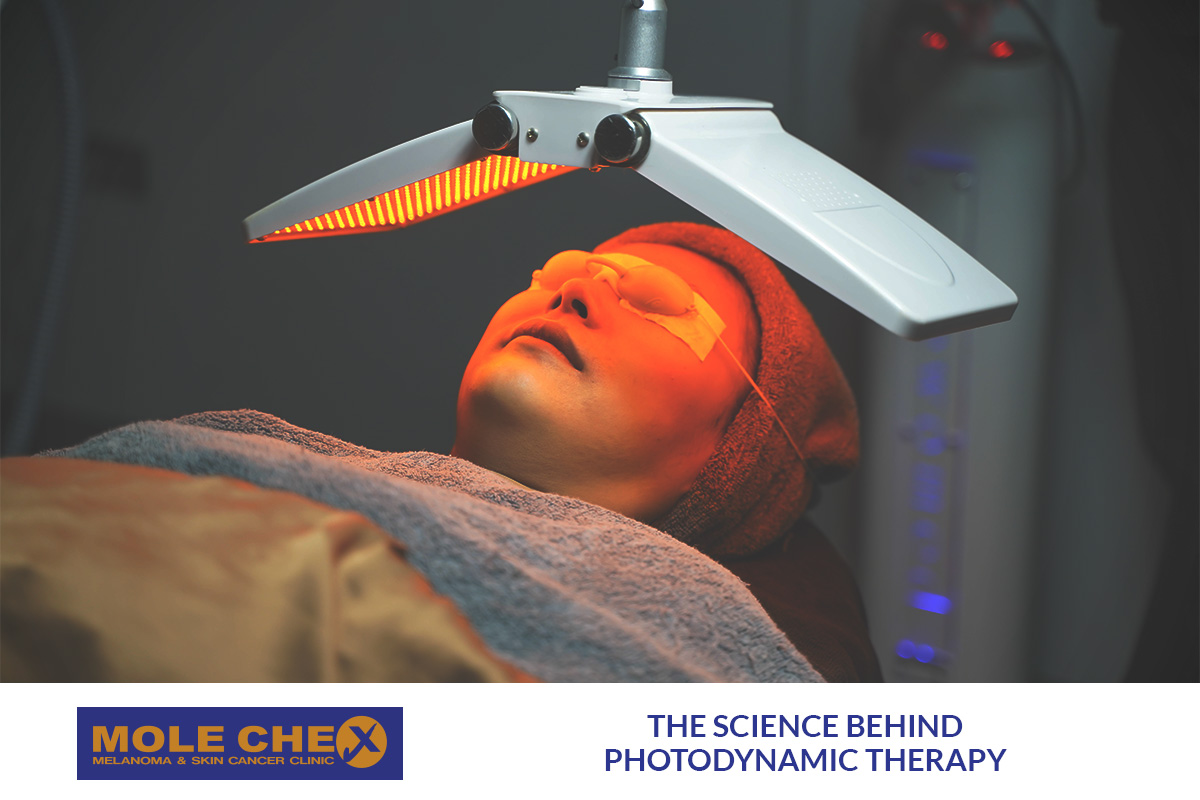The Science Behind Photodynamic Therapy: How It Treats Skin Cancer Effectively

Using the power of light, photodynamic therapy (PDT) is a state-of-the-art method for effectively targeting and treating skin cancer. This novel method minimises damage to nearby healthy tissue by destroying malignant cells with a photosensitizing chemical and a targeted light wavelength.
We shall examine the science of PDT, its advantages, and its efficacy in treating skin cancer in this post.
In this article, we will cover:
- The basics of Photodynamic Therapy
- How PDT works to treat skin cancer
- The benefits of PDT
- The procedure and what to expect
- Post-treatment care and potential side effects
Understanding Photodynamic Therapy (PDT)
Photodynamic Therapy is a two-step process involving the application of a photo-sensitizing agent followed by exposure to a specific type of light. This combination creates a reaction that destroys cancerous cells.
The Photosensitizing Agent
The photosensitizing agent, typically applied topically, is absorbed by cancerous cells. These agents can also be administered intravenously, depending on the type and location of the cancer being treated. Common agents used in PDT include aminolevulinic acid (ALA) and methyl aminolevulinate (MAL).
The Light Source
After the photosensitizing agent has been absorbed by the cancerous cells, the area is exposed to a specific wavelength of light. This light can be delivered using lasers, LEDs, or other light sources. The wavelength of light used is crucial as it activates the photosensitizing agent, causing a reaction that generates reactive oxygen species (ROS) which ultimately destroy the cancer cells.
How PDT Treats Skin Cancer
Targeted Action
The beauty of PDT lies in its precision. The photosensitizing agent selectively accumulates in cancerous cells. When exposed to the light source, only the cells that have absorbed the agent are targeted, minimizing damage to surrounding healthy tissue. This targeted action makes PDT a highly effective treatment for certain types of skin cancer, including basal cell carcinoma (BCC) and squamous cell carcinoma (SCC).
Mechanism of Cell Destruction
Once activated by light, the photosensitizing agent produces ROS. These reactive molecules cause direct damage to the cancer cell’s membranes, proteins, and DNA, leading to cell death. This mechanism ensures that the cancerous cells are effectively destroyed while sparing healthy skin cells.
Immune System Activation
PDT not only destroys cancer cells directly but also stimulates the body’s immune response. The cell death caused by PDT releases tumour antigens, which can activate the immune system to recognize and attack remaining cancer cells, providing an additional layer of defence against cancer recurrence.
Benefits of Photodynamic Therapy
Minimally Invasive
PDT is a minimally invasive treatment that does not require surgical incisions, reducing the risk of infection and other complications associated with surgery.
Precision and Effectiveness
The targeted nature of PDT allows for precise treatment of cancerous cells, ensuring high effectiveness while preserving healthy tissue.
Cosmetic Outcomes
PDT is known for its excellent cosmetic outcomes. It leaves minimal scarring and can improve the appearance of the treated area, making it an attractive option for visible areas like the face and hands.
Short Recovery Time
Patients typically experience a shorter recovery time with PDT compared to traditional surgical methods. This allows for a quicker return to normal activities.
The PDT Procedure: What to Expect
Pre-Treatment Preparation
Before the procedure, the area to be treated will be cleaned, and the photo-sensitizing agent will be applied. This agent is usually left on the skin for a period ranging from a few hours to a day, allowing it to be absorbed by the cancerous cells.
Light Activation
Once the agent has been adequately absorbed, the area is exposed to the specific wavelength of light. The duration of light exposure can vary but typically lasts between 10 to 45 minutes, depending on the size and location of the treatment area.
Post-Treatment Care
After the procedure, patients are advised to avoid direct sunlight and bright indoor light for at least 48 hours. As the treated area will be photosensitive. It is also important to follow any additional care instructions provided by your healthcare provider to ensure optimal healing and results.
Potential Side Effects
PDT is generally well-tolerated however, some patients may experience side effects such as:
- Redness and Swelling: Temporary redness and swelling at the treatment site are common and usually subside within a few days.
- Pain or Discomfort: Mild pain or discomfort during light exposure can occur but is typically manageable with over-the-counter pain relief.
- Photosensitivity: Increased sensitivity to light in the treated area is expected and necessitates strict avoidance of direct sunlight for a specified period.
Conclusion
So, Photodynamic Therapy is a highly effective and innovative treatment for skin cancer, offering precision, minimal invasiveness, and excellent cosmetic results. By understanding the science behind PDT and its benefits, patients can make informed decisions about their treatment options. Molechex provides advanced and effective treatments such as PDT to achieve the best possible outcomes and help our patients . Finally, Explore the benefits of Photodynamic Therapy and take the first step towards effective skin cancer treatment today! 🌟
Learn more by reading other articles :
